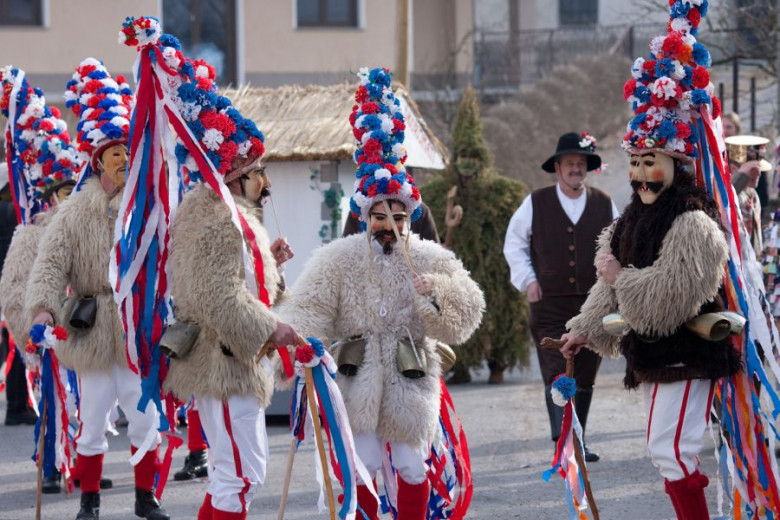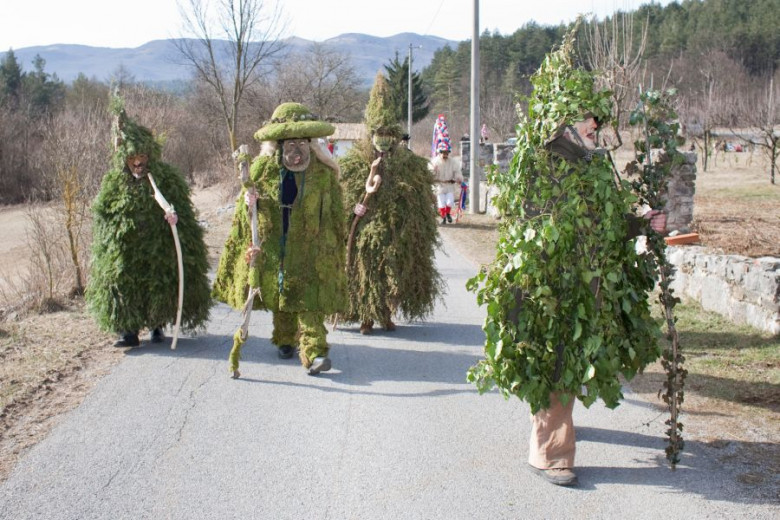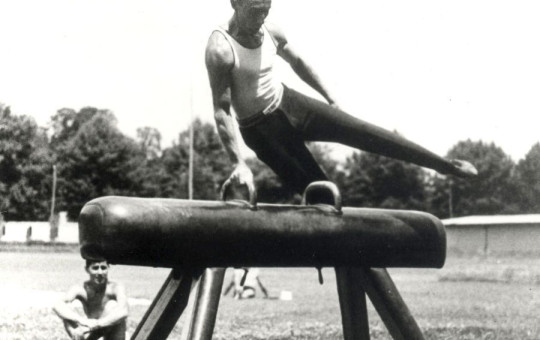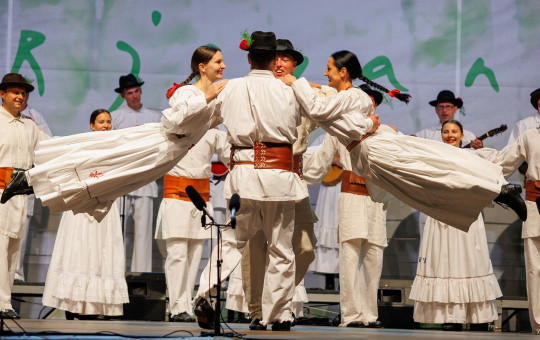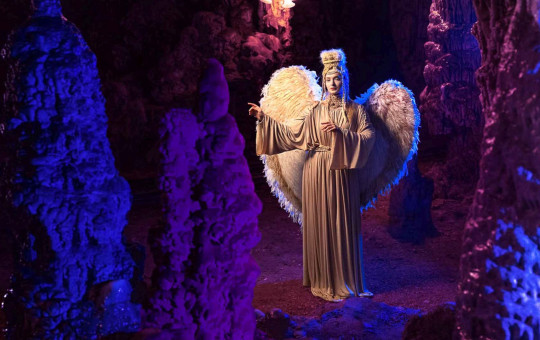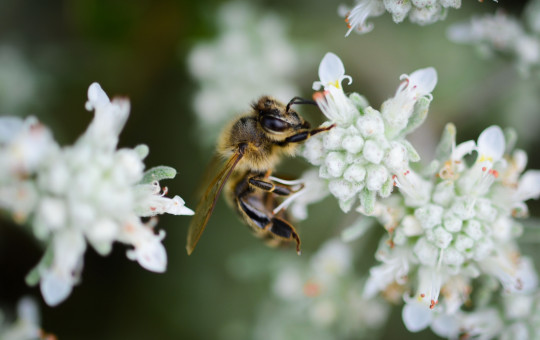In the village of Hrušica in the Brkini Hills, the preparations for the Shrovetide Carnival begin promptly after St Stephen’s Day on 26 December. Kápoti – the Carnival leaders – are the key figures in the preparations, and masks and equipment are hurriedly prepared a week before the Carnival by other participants in the event, called Škoromatija. Once they put on their Škoromati costumes and ring their cowbells, the carnival merrymaking begins.
The origins of Škoromatija date back at least 700 years in the Brkini Hills, and the names of the masks and of the celebration itself have been preserved to date.
Records of "scaramatte" and "sgaravatte", persons wearing Carnival masks, can be found in 14th and 15th century archives of the towns of Cividale del Friuli and Udine, Italy.
The two words are presumed to stand for a company guard, who is the main character of Škoromati – the fearsome Škopiti. Based on these records, it can be assumed that Škoromati are the first and the oldest Slovenian masks mentioned in written sources.
-
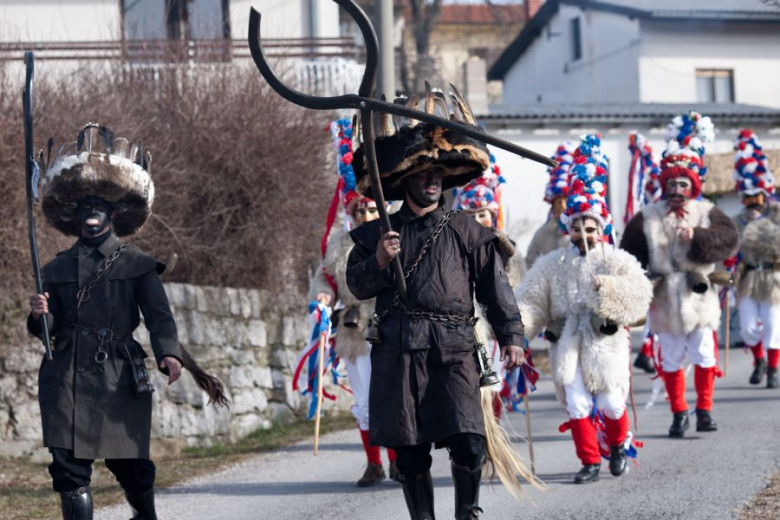
Škopiti is the central figure of škoromati and is the only directly descended from the medieval scaramatte. Photo: Helena Race
-
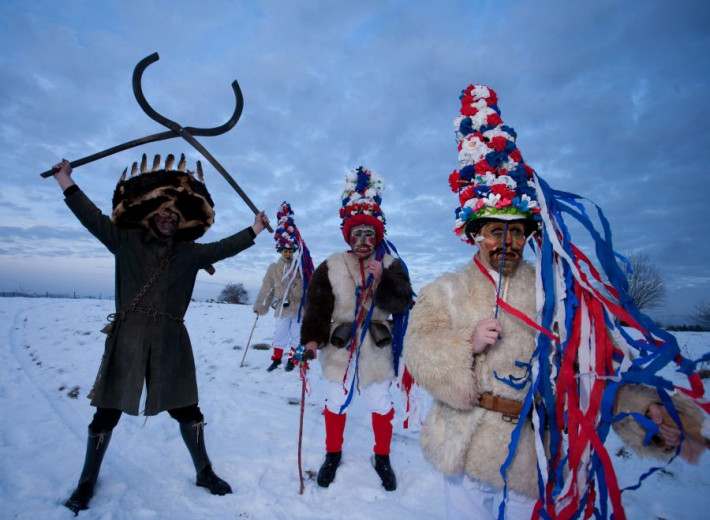
The origins of Škoromatija date back at least 700 years in the Brkini Hills, and the names of the masks and of the celebration itself have been preserved to date. Photo: Helena Race
Today, Škopiti is the central figure of Škoromati and the only direct descendant of the medieval scaramatte.
Over time, the term Škoromat began to denote all Shrovetide characters in the Brkini Hills. Most visual characteristics have been preserved in the character of Škopiti, also known in some places as Kleščar ("a man with tongs"). The Škopiti wears a broad hat covered with rabbit skins and bird feathers attached to the brim. To make himself even more frightening, he usually hangs a bird of prey or a crow on his hat. His face and hands are smeared with soot, and he carries with him large and heavy wooden tongs that make a constant clattering noise. Sometimes, a group of Škoromati consists of two Škopiti, however, there is usually only one, who tends to be the biggest and the strongest young man in the village.
-
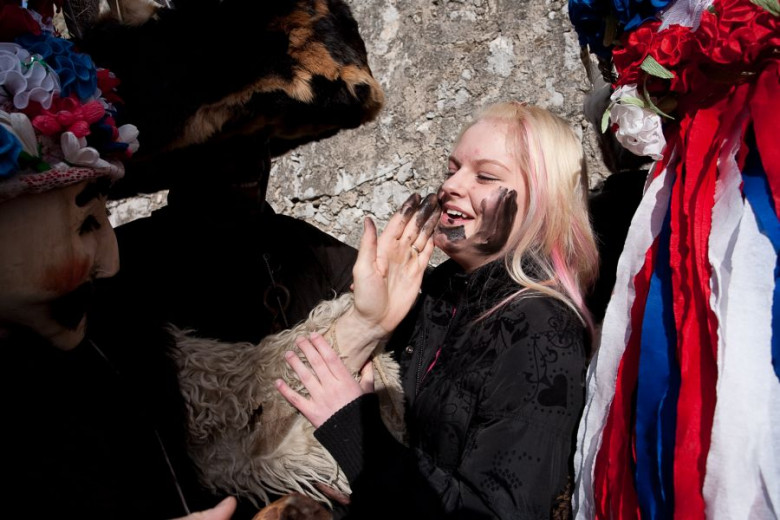
The Shrovetide character of Škopiti is quite wild and scares children, chases young girls and smears their faces with soot, assisted by other Škoromati. Soot represents the vital power of men, and by smearing girls’ faces, the Škoromati symbolically ensure fertility and consequently, the survival of the entire community. Photo: Helena Race
A motley crew
Most of the Škoromati in the group carry cowbells and they are the loudest. Their carnival costume is colourful and very attractive. They wear conical hats measuring up to 70 centimetres in height, dotted by a hundred or more red, white and blue crepe paper flowers, with long colourful paper ribbons that fall over the Škoromati’s backs and almost touch the ground. They wear sheepskin costumes with bells tied around their waists, white trousers with a red line up the side and bright red socks. Along with their hats, the most valuable piece of attire is their wooden masks, carved from a single piece of wood.
In spite of their attractive carnival gear, the Škoromati with bells are very naughty and are considered the "ugly" ones. All day, they run around the village, ringing their bells loudly and help the Škopiti catch girls and smear them with soot.
To be a Škoromat with bells is a great honour, although running all day is tiresome, as their equipment can weigh up to 15 kg.
A place of honour among Škoromati is reserved for the polite and friendly Poberini ("Collectors"). These are the only carnival characters that enter people’s homes to wish them a good harvest and collect gifts.
They have to be careful not to miss any of the houses in the village as this would be considered an insult. They do not cover their faces, but dress in festive attires, their only accessories being ribbons on their hats, a white apron and a small bouquet of flowers on their chests. There are usually two Poberini. They are accompanied by a Škoromat with bells and no mask, since the locals have to see whom they are welcoming into their homes. The Škoromat announces its arrival by ringing its bells.
The Pepeljuhar ("Ashman") is another important, as well as one of the oldest, masked character.
This character, dressed in long, worn-out and torn black clothing, carrying a bag or a basket in which ashes are mixed with crushed hay, can impersonate an old man or woman. He spreads ashes in courtyards and onto thresholds, thus wishing good health and a good harvest.
One of the most beautiful masks is the ti zeleni ("the green one"), decorated with juniper and pine branches, heather, ivy and moss.
It symbolises the approaching spring, birth and life.
Carnival characters also include a bride and a groom, a Turk, Marko the Bear, a Gypsy couple, a Cunjar ("the Ragman") and the ta debel ("the fat one"). One should not forget the band, which adds rhythm to the whole carnival procession with the sounds of the accordion and drums.
The Hrušica Škoromati
The Škoromatija tradition has been kept alive by the Hrušica Culture Association – Škoromati Section, established in 1995, but with a rich history of activity in this field even before that date.
The Škoromati of Hrušica make their masks themselves, and store them at home until the next Carnival. The crepe paper flowers in the colours of the Slovenian flag, which adorn their hats, are mostly made by women (Škoromati’s mothers, wives, sisters) while the wooden masks are made by skilful carvers of the village. "According to ancient tradition, Škoromati masks were only worn by unmarried men. All škoromati groups now break this rule, and married men and even children dress as Škoromati, since it is difficult to keep a custom alive without letting the youngest ones to grow up with it," explains Danijel Cek, a member of the Hrušica Culture Association.
Shrovetide is a time of follies, joy and merrymaking, and škoromatija is an opportunity for young and not so young men of Hrušica to have a laugh and play tricks which they would never dare do without a mask.
Date: 17. February 2020
Time to read: 5 min

